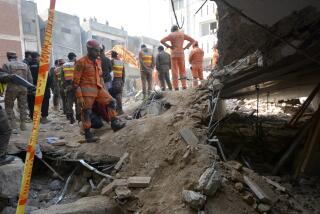Details emerge of Pakistani Taliban’s suspected role in Times Square bombing
- Share via
Reporting from Washington — The main suspect in the attempted Times Square bombing received several days of training in Pakistan’s Mohmand region and roughly $15,000 from the Pakistani Taliban to finance the attack, according to U.S. officials briefed on the case.
It appears likely that Faisal Shahzad, the Pakistani American accused of leaving a Nissan Pathfinder loaded with fertilizer and propane tanks in Times Square on May 1, came up with the idea of the car bomb himself, one official said. Shahzad then apparently persuaded the militant group to give him assistance when he traveled to Pakistan’s border region in 2009 or early 2010, they said.
“The targeting part of it was his,” said one official briefed on the case, speaking on condition of anonymity. “But the guy was convincing enough to get resources.”
The findings are part of a growing body of evidence that the Pakistani Taliban, known as Tehrik-e-Taliban Pakistan, was deeply involved in the attempted bombing, the officials said, though they acknowledged that key questions remain unanswered.
Investigators are still attempting to determine what role senior Pakistani Taliban leaders played in the operation.
Shahzad has told investigators that he met with Hakimullah Mahsud, the leader of the Pakistani Taliban, before returning to the United States to carry out the attempted bombing, two senior officials said. His claim has been repeated by at least one other source — a suspect arrested in Pakistan with ties to the militant group, the officials said.
But U.S. intelligence agencies are still attempting to corroborate that a meeting occurred between Shahzad and Mahsud. “There are a number of people talking about this,” one of the officials said. “All of these comments need to be worked through and verified.”
Shahzad has provided interrogators with numerous details about the operation, to the point that some officials are concerned he may be embellishing his account. It was Shahzad, for instance, who first revealed that he had received five days of training in the Mohmand region, in Pakistan’s tribal belt near the Afghanistan border.
Officials have been able to corroborate that part of Shahzad’s story, one U.S. official said. But investigators are still trying to figure out why he went to Mohmand, which is several hundred miles north of the Pakistani Taliban stronghold in North Waziristan.
Although U.S. officials say they assume Shahzad received bomb-making training, the suspect’s crude attempt to construct a workable explosive had very little chance of causing a large number of casualties.
In recent days investigators have turned up evidence beyond that provided by Shahzad and his suspected associate being held in Pakistan, whom officials refused to identify. The alleged associate’s arrest was first reported by the Washington Post.
“We’ve learned who was involved in this from the interrogations, and we’ve got independent validation from outside the interrogations,” said a senior administration official, also speaking on condition of anonymity.
Investigators have been able to develop a better understanding of the financial support Shahzad received, with the arrest in recent days of three people — two in Boston and one in Maine — who may have been involved in the transfer of the funds from Pakistan, the officials said. It does not appear likely that they were aware of the purpose of the money transfers.
Shahzad’s visit to Pakistan last year coincided with an intensification of the U.S. drone strikes near the Afghan border, including airstrikes targeting Mahsud. For that reason, some U.S. officials are doubtful that Mahsud would have risked a meeting with an American, even one volunteering to carry out a terrorist attack, for fear that he was being set up.
On the other hand, Mahsud — believed to be the architect of a series of suicide bombings and raids on markets, mosques and security installations in the latter half of 2009 — appears to have become increasingly determined to strike at U.S. targets. In a video released in January, he appeared with the Jordanian suicide bomber who carried out an attack the month before on a CIA base in Khowst, Afghanistan, that killed seven CIA employees.
Even if Mahsud was not personally involved in the attempted Times Square attack, the support allegedly provided to Shahzad is evidence that the Pakistani Taliban has broadened its focus beyond targets in Pakistan. The group has formed closer links over the last two years with Al Qaeda, whose leaders and fighters are also hiding in the Pakistani border region, officials said, which may help explain an opportunistic attempt to strike the U.S.
Pakistani officials are continuing to play down the possibility that Shahzad was linked to the Taliban, though they stress that they are cooperating with U.S. investigators sent to Pakistan to assist in the case.
U.S. officials said that the Pakistani government’s contention that Shahzad operated without Taliban help may be aimed at avoiding a situation in which it could be compelled to undertake military operations against militant groups in North Waziristan before it is ready. Pakistani officials have promised to undertake clearing operations there, but have not begun.
Despite the growing U.S. confidence that the Pakistani Taliban was involved, American military officials said there were no plans to use the Times Square case to ratchet up the pressure on the Pakistani military. Adm. Michael G. Mullen, chairman of the Joint Chiefs of Staff, recently called Ashfaq Kayani, the Pakistani army chief of staff, to discuss the situation.
“There’s no effort underway to convince the Pakistanis that they need to accelerate their timetable” for North Waziristan, said Capt. John Kirby, a spokesman for Mullen.
Ken Dilanian in the Washington bureau and Times staff writer Alex Rodriguez in Islamabad, Pakistan, contributed to this report.
More to Read
Sign up for Essential California
The most important California stories and recommendations in your inbox every morning.
You may occasionally receive promotional content from the Los Angeles Times.














